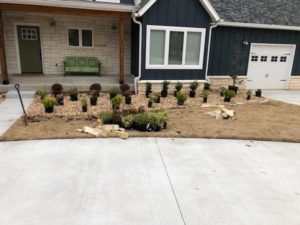Grand Lake Landscaping: A Guide to a Thriving Yard
Updating your landscape around Grand Lake o' the Cherokees offers a unique opportunity to create a stunning outdoor space. With its beautiful shorelines and distinct four-season climate, the region presents both exciting possibilities and specific challenges. A thoughtful approach to landscaping not only boosts your property's curb appeal but also creates a more enjoyable and sustainable environment for you and your family.
This guide will walk you through the key factors for a successful landscape update in the Grand Lake area. We'll cover everything from soil and climate considerations to selecting the perfect plants and materials. By the end, you will have a clear roadmap for transforming your yard into a beautiful, functional, and resilient lakeside retreat.
Understanding the Grand Lake Climate and Soil
Success starts from the ground up. Before you buy a single plant, it’s crucial to understand the local environment. Grand Lake's climate and soil composition will dictate what thrives and what struggles in your yard.
Navigating the Oklahoma Weather Rollercoaster
Grand Lake experiences a humid subtropical climate. This means hot, humid summers and generally mild to cool winters, with occasional cold snaps and ice. Our weather can be unpredictable, with intense rainstorms, periods of drought, and strong winds. Your landscape plan must account for these extremes.
Choose plants that can handle both the summer heat and potential winter freezes. Flexible, sturdy trees and shrubs that can withstand strong winds are also a wise investment, especially for properties close to the water.
Working with Northeast Oklahoma Soil
The soil around Grand Lake is predominantly clay-based. While rich in nutrients, clay soil is dense and drains slowly. This can lead to waterlogged roots, a common problem for many plants. On the other hand, during dry spells, clay can become hard and compacted, making it difficult for water to penetrate.
To improve your soil, consider amending it with organic matter like compost or pine bark fines. This will improve drainage, aeration, and water retention. Performing a simple soil test can also provide valuable insights into its pH level and nutrient content, helping you make more informed decisions.
Choosing the Right Plants for Grand Lake
Selecting plants that are well-suited to our specific region is the most important factor in creating a low-maintenance and long-lasting landscape. Native plants are often the best choice, as they have evolved to thrive in our local conditions.
The Power of Native Plants
Native Oklahoma plants are naturally adapted to our soil, rainfall patterns, and temperature swings. They require less water, fertilizer, and pest control than non-native species, saving you time and money. Plus, they provide essential food and shelter for local wildlife, including pollinators like bees and butterflies.
Recommended Native Plants for the Grand Lake Area:
- Trees: Eastern Redbud, Shumard Oak, Bald Cypress
- Shrubs: American Beautyberry, Buttonbush, Spicebush
- Perennials: Purple Coneflower, Black-Eyed Susan, Indian Blanket
- Grasses: Little Bluestem, Switchgrass
Blending Beauty and Function
Your plant selection should be both beautiful and practical. Consider the mature size of each plant to avoid overcrowding down the road. Think about layering different heights, textures, and colors to create visual interest throughout the year. For lakeside properties, planting deep-rooted grasses and shrubs along the shoreline can help prevent erosion.
Smart Design and Material Choices
A great landscape is more than just plants. Hardscaping—the non-living elements like patios, walkways, and retaining walls—provides structure and usability to your outdoor space.
Water Conservation Strategies
Water is a precious resource, and designing a water-wise landscape is both environmentally responsible and cost-effective. Group plants with similar water needs together to make irrigation more efficient. This practice, known as hydrozoning, prevents overwatering some plants while underwatering others.
Using mulch is another key strategy. A two- to three-inch layer of organic mulch (like shredded bark or wood chips) helps retain soil moisture, suppresses weeds, and regulates soil temperature. Consider installing a drip irrigation system or soaker hoses, which deliver water directly to the plant roots with minimal waste from evaporation.
Selecting Durable Materials
The materials you choose for patios, decks, and walkways should be able to withstand the Grand Lake climate. Natural stone, such as flagstone sourced from Oklahoma quarries, is an excellent choice for its durability and rustic appeal. For decking, composite materials often hold up better than traditional wood against the humidity and sun exposure common in our area.
Seasonal Maintenance for Year-Round Beauty
Your landscape's needs will change with the seasons. A proactive maintenance plan ensures your yard looks its best all year long.
- Spring: This is the time for cleaning up winter debris, applying a fresh layer of mulch, and fertilizing your lawn and plants as they emerge from dormancy. It's also the ideal time for planting new trees, shrubs, and perennials.
- Summer: The primary focus is watering. Water deeply and infrequently in the early morning to minimize evaporation. Keep an eye out for pests and diseases, which can thrive in the heat and humidity.
- Fall: As temperatures cool, it’s a great time to plant, divide perennials, and overseed your lawn. Rake fallen leaves and add them to your compost pile to create nutrient-rich soil for next year.
- Winter: Prune dormant trees and shrubs to encourage healthy growth in the spring. Protect any sensitive plants from potential frost with a layer of mulch or a frost blanket.
Partner with a Local Landscaping Expert
While DIY landscaping can be rewarding, the unique challenges of the Grand Lake area make professional guidance invaluable. A local landscaping expert brings a deep understanding of the regional climate, soil types, and plant life. They can help you avoid costly mistakes and design a landscape that is both beautiful and sustainable.
Local professionals have established relationships with area nurseries and suppliers, ensuring you get the healthiest plants and highest-quality materials. From initial design to installation and ongoing maintenance, working with an expert ensures your vision becomes a reality that will thrive for years to come.
